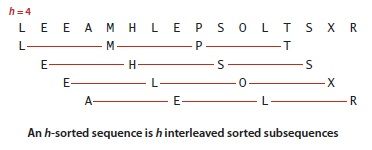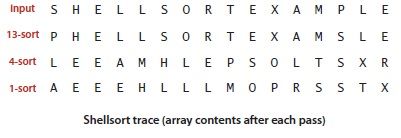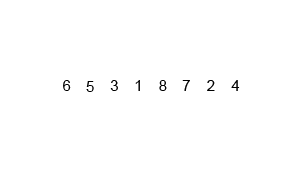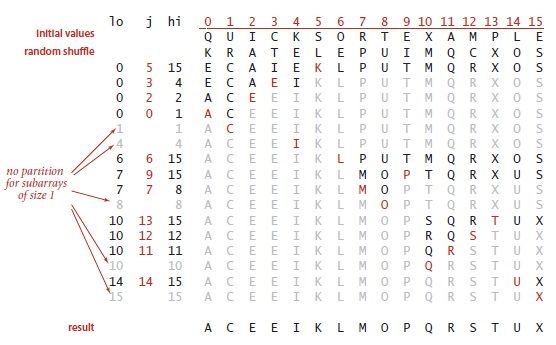算法入门(一) 排序
摘自 <Algorithms_4th> Robert Sedgewick, chapter 2 sorting
the following class illustrates the conventions that we will use
public class Example { public static void sort(Comparable[] a) { /* See Algorithms 2.1, 2.2, 2.3, 2.4, 2.5, or 2.7. */ } private static boolean less(Comparable v, Comparable w) { return v.compareTo(w) < 0; } private static void exch(Comparable[] a, int i, int j) { Comparable t = a[i]; a[i] = a[j]; a[j] = t; } private static void show(Comparable[] a) { // Print the array, on a single line. for (int i = 0; i < a.length; i++) StdOut.print(a[i] + " "); StdOut.println(); } public static boolean isSorted(Comparable[] a) { // Test whether the array entries are in order. for (int i = 1; i < a.length; i++) if (less(a[i], a[i-1])) return false; return true; } public static void main(String[] args) { // Read strings from standard input, sort them, and print. String[] a = In.readStrings(); sort(a); assert isSorted(a); show(a); } }
1 elementary sort
1) selection sort 选择排序
first, find the smallest item in the array and exchange it with the first entry;
then, find the next smallest item and exchange it with the second entry; continute until the entire entry is sorted
Java 实例:
public class Selection { public static void sort(Comparable[] a) { // Sort a[] into increasing order. int N = a.length; // array length for (int i = 0; i < N; i++) { // Exchange a[i] with smallest entry in a[i+1...N). int min = i; // index of minimal entr. for (int j = i+1; j < N; j++) if (less(a[j], a[min])) min = j; exch(a, i, min); } } }
2) insertion sort 插入排序
sort bridge hands: consider one at a time, insert each into proper place among those already sorted
computer implementation: before inserting the current item, move larger items one position to the right to make space
打扑克:摸牌 -> 插牌 -> 再摸牌 -> 插牌 -> ... ...
Java 实例:
public class Insertion { public static void sort(Comparable[] a) { // Sort a[] into increasing order. int N = a.length; for (int i = 1; i < N; i++) { // Insert a[i] among a[i-1], a[i-2], a[i-3]... .. for (int j = i; j > 0 && less(a[j], a[j-1]); j--) exch(a, j, j-1); } } }
3) shell sort
a fast algorithm based on insertion sort
a h-sorted array: taking every hth entry(starting anywhere) yields a sorted subsequence
Java 实例:
public class Shell { public static void sort(Comparable[] a) { // Sort a[] into increasing order. int N = a.length; int h = 1; while (h < N/3) h = 3*h + 1; // 1, 4, 13, 40, 121, 364, 1093, ... while (h >= 1) { // h-sort the array. for (int i = h; i < N; i++) { // Insert a[i] among a[i-h], a[i-2*h], a[i-3*h]... . for (int j = i; j >= h && less(a[j], a[j-h]); j -= h) exch(a, j, j-h); } h = h/3; } } }
2 merge sort 合并排序
1) overview
to sort an array, divide it into two havles, sort the two halves(recursively), and then merge the results
2) merge method
Java 实例:
public static void merge(Comparable[] a, int lo, int mid, int hi) { // Merge a[lo..mid] with a[mid+1..hi]. int i = lo, j = mid+1; for (int k = lo; k <= hi; k++) // Copy a[lo..hi] to aux[lo..hi]. aux[k] = a[k]; for (int k = lo; k <= hi; k++) // Merge back to a[lo..hi]. if (i > mid) a[k] = aux[j++]; else if (j > hi ) a[k] = aux[i++]; else if (less(aux[j], aux[i])) a[k] = aux[j++]; else a[k] = aux[i++]; }
3) top-down mergesort
Java 实例:
public class Merge { private static Comparable[] aux; // auxiliary array for merges public static void sort(Comparable[] a) { aux = new Comparable[a.length]; // Allocate space just once. sort(a, 0, a.length - 1); } private static void sort(Comparable[] a, int lo, int hi) { // Sort a[lo..hi]. if (hi <= lo) return; int mid = lo + (hi - lo)/2; sort(a, lo, mid); // Sort left half sort(a, mid+1, hi); // Sort right half merge(a, lo, mid, hi); // Merge results } }
left half: sort(a,0,15) -> sort(a,0,7) -> sort(a,0,3) -> sort(a,0,1) -> merge(a,0,0,1) -> sort(a,2,3) -> merge(a,2,2,3) -> merge(a,0,1,3)
-> sort(a,4,7) -> sort(a,4,5) -> merge(a,4,4,5) -> sort(a,6,7) -> merge(a,6,6,7) -> merge(a,4,5,7) -> merge(a,0,3,7)
3 quick sort 快速排序
1) overview
partition an array into two subarrays, then sort the subarrays independently
2) partition method
three conditions:
a) the entry a[j] is in its final place in the array, for some j
b) no entry in a[lo] through a[j-1] is greater than a[j]
c) no entry in a[j+1] through a[hi] is less than a[j]
Java 实例:
private static int partition(Comparable[] a, int lo, int hi) { // Partition into a[lo..i-1], a[i], a[i+1..hi]. int i = lo, j = hi+1; // left and right scan indices Comparable v = a[lo]; // partitioning item while (true) { // Scan right, scan left, check for scan complete, and exchange. while (less(a[++i], v)) if (i == hi) break; while (less(v, a[--j])) if (j == lo) break; if (i >= j) break; exch(a, i, j); } exch(a, lo, j); // Put v = a[j] into position return j; // with a[lo..j-1] <= a[j] <= a[j+1..hi]. }
3) quick sort
Java 实例:
public class Quick { public static void sort(Comparable[] a) { StdRandom.shuffle(a); // Eliminate dependence on input. sort(a, 0, a.length - 1); } private static void sort(Comparable[] a, int lo, int hi) { if (hi <= lo) return; int j = partition(a, lo, hi); // Partition (see page 291). sort(a, lo, j-1); // Sort left part a[lo .. j-1]. sort(a, j+1, hi); // Sort right part a[j+1 .. hi]. } }






